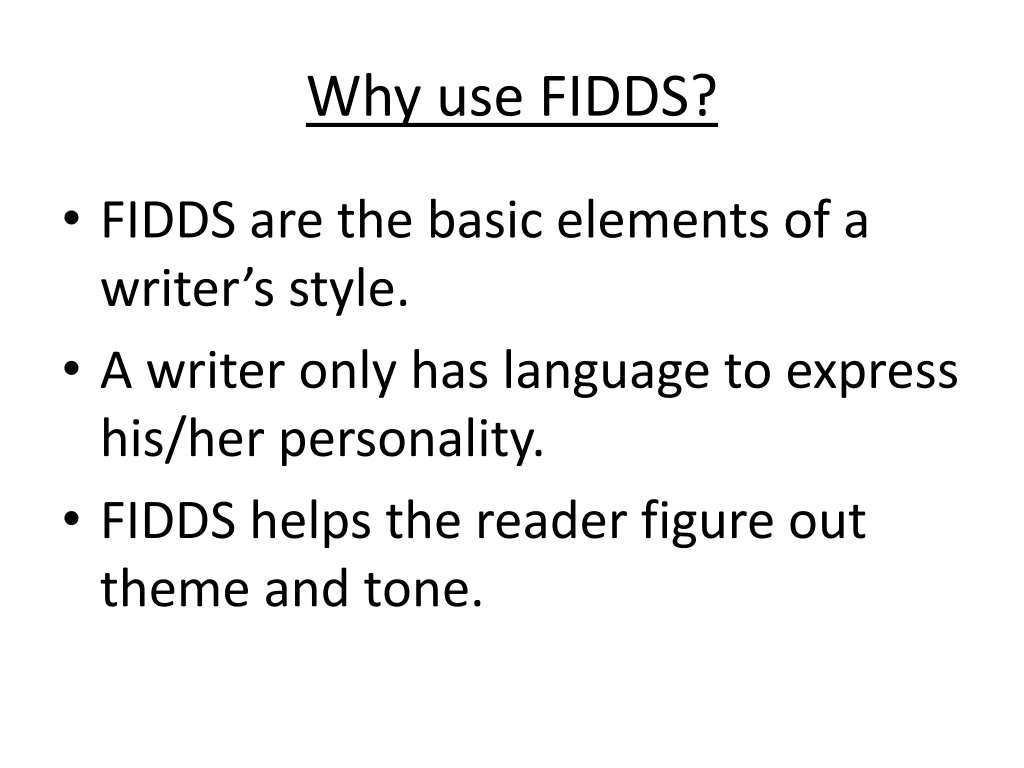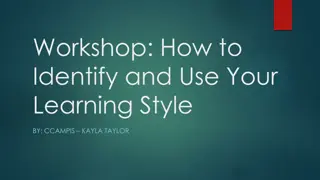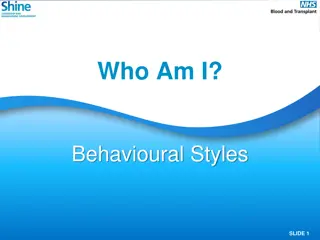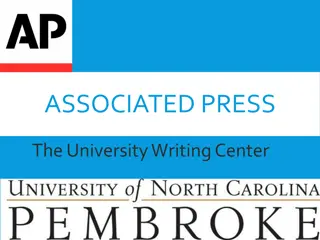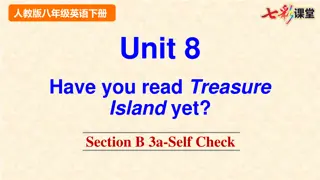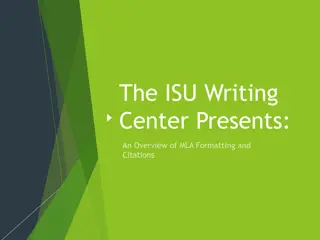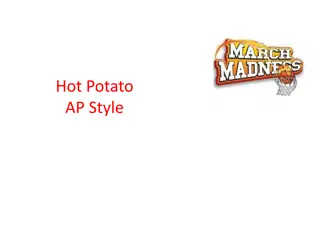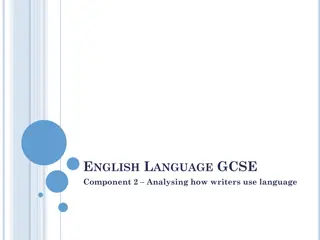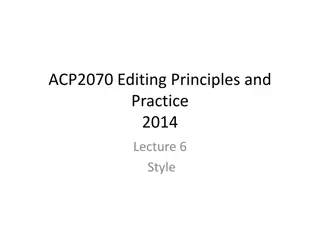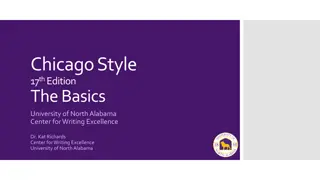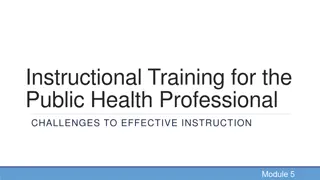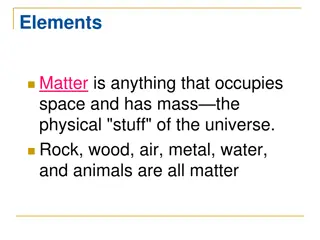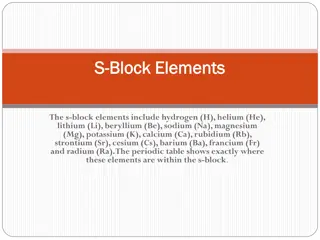FIDDS: Elements of Writer's Style
FIDDS, comprised of figurative language, imagery, diction, detail, and syntax, are essential elements that define a writer's style and help readers uncover the theme and tone of a piece. This content delves into examples of metaphors, similes, personification, hyperboles, symbols, and irony, illustrating how these literary devices contribute to the creation of tone and theme in writing.
Download Presentation

Please find below an Image/Link to download the presentation.
The content on the website is provided AS IS for your information and personal use only. It may not be sold, licensed, or shared on other websites without obtaining consent from the author.If you encounter any issues during the download, it is possible that the publisher has removed the file from their server.
You are allowed to download the files provided on this website for personal or commercial use, subject to the condition that they are used lawfully. All files are the property of their respective owners.
The content on the website is provided AS IS for your information and personal use only. It may not be sold, licensed, or shared on other websites without obtaining consent from the author.
E N D
Presentation Transcript
Why use FIDDS? FIDDS are the basic elements of a writer s style. A writer only has language to express his/her personality. FIDDS helps the reader figure out theme and tone.
FIDDS MEAN FIDDS stands for figurative language, imagery, diction, detail, and syntax As you read, try to find examples of these elements and explain why these elements are important how they help to create tone and theme.
Figurative Language Includes: Metaphor, Simile, Personification, Hyperbole, Symbols, and Irony
Metaphor Examples A football player is a bulldozer on the field. The catcher was the bomb! Remember: Metaphors compare two unlike objects. They imply the comparison.
Simile Examples Mary has the face like a rose. Jimmy ran like a cheetah to the base. Remember: A simile directly compares two unlike objects using like, as, than, similar to, or resembles.
Personification Examples Lea s friendship wrapped my sadness in a warm blanket. The tree sighed sadly in the cold. Remember: Personification gives human qualities to something that is not human, such as an object, idea, or animal.
Hyperbole Examples Definition: Hyperbole is an exaggeration that is based in truth. I m so tired I could sleep for a week. I was hungry enough to eat a cow. I laughed until my sides split open wide.
Symbol Examples Definition: A symbol is something that stands for itself. A symbol is literal but it represents something else. Rose is a symbol of love. Rainbow is a symbol of hope. Flag symbol of country. Moon symbol for mystery.
Irony Examples Definition: Irony is saying the opposite of what you mean. Irony can be funny, serious, affectionate, or hateful. This is what makes it sometimes hard to understand. Example: You just got served a disgusting and overcooked meal for lunch. You say Great lunch! It is stormy and lightning bolts are crashing outside and you comment-- What a great day for a swim!
IMAGERY Imagery appeals to your 5 senses: SIGHT, SMELL, SOUND, TASTE, TOUCH
Imagery Examples Sight: Eerie glow in the morning fog Sound: shrieking, wailing, moaning, creaking Smell: The putrid rise of garbage stench filled the air. Taste: The soup seems bitter and laced with phlegm. Touch: The mud oozed in my palm.
DICTION Diction is isolated words that the author chose when writing. Diction guides the meaning an author wants the reader to take away from the text. This word choice covers both connotation (the feeling the word gives the reader) and denotation (the literal meaning of the word).
Diction Examples Instead of childish use childlike Instead of stand use slouch Instead of pretty use delicate Instead of emptying use throwing Words create feelings inside the reader. Word choice must be deliberate and specific in order to make sure that the meaning that was intended is actually created.
DETAILS Details are facts the help color an otherwise drab picture for the reader. Gives focus to writing. Details give life to characters, settings, and situations. Sometimes, it s the details the author leaves out that makes the strongest point.
Details Examples He was an old man. His black, heavily wrinkled face was surrounded by a halo of crinkly white hair and whiskers that seemed to separate his head from the layers of dirty coats piled on his smallish frame. The Treasure of Lemon Brown by Walter Dean Myers Contrasting details: layers of dirty coats make him seem padded and heavy; but the small frame makes him seem frail The details also give the reader a mental picture of the old man
SYNTAX Syntax is the structure of the text. It is how punctuation, sentence structure, sentence length, or repetition of words are used in the text. The structure is how the piece is crafted.
Syntax Example Elements of Syntax: sentence parts, word order, sentence length, punctuation Original: He was a year older than I, skinny, brown as a chocolate bar, his hair orange, his hazel eyes full of mischief and laughter. Breakdown of original: Older: comparative of an adjective; skinny: adjective; brown as a chocolate bar: simile that describes subject; orange: adjective; full of mischief and laughter: adjective phrase. You try: He/She was ___________________ (comparative of an adjective) than I, ________________(adjective), ___________________(simile that describes the subject), his/her hair ______________(adjective), his/her eyes ___________________ (adjective phrase).
